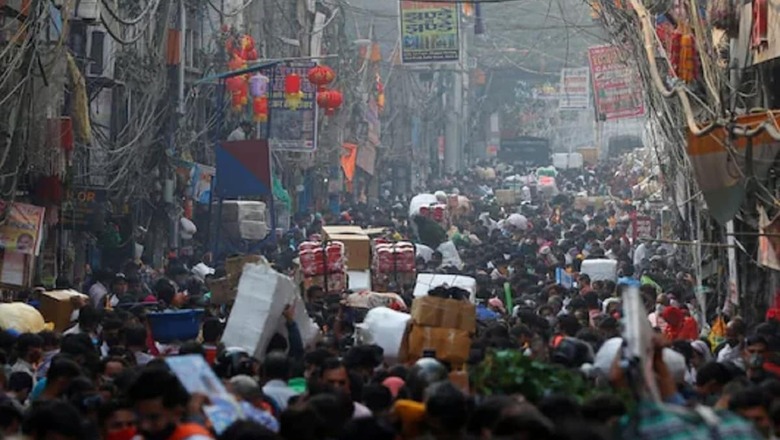
views
Though India’s large population base is seen as its demographic dividend with the working-age population between 15 to 64 years being larger than the dependent population, at the same time, this large population base also puts pressure on the resources available in the country to support it, particularly when India is a country with just 2.4% of the world’s landmass that carries 17.70% of its population.
India’s population was 102 crore in 2001, which increased to 121 crore in 2011, and as per Census 2011 projection, it currently stands at 136.16 crore.
The growth of population for India has meant reduced availability of basic resources needed to support life. Per capita arable land, per capita water availability, number of jobseekers, doctor to population ratio and per capita energy consumption are the fundamental factors for a sustainable life that, arguably, are inversely proportional to population growth.
Arable land
A growing population means the country needs to increase food production, but India, as per the United Nations Statistical Commission, has just 2.4% of the world’s total landmass. Though India has the largest arable land in the world as per US Geological survey, that is 60.3% of its total area as assessed by the World Bank, its per capita arable land is decreasing with each population Census exercise after 10 years.
The information available from the World Bank shows India had 0.149 hectare of arable land available per person as in 2001. It reduced to 0.125 hectare in 2011 while the latest figure from 2018 shows a further reduction to 0.116 hectare. This means each Indian now has less arable land to support his food needs.
Combine it with the fact that India has the lowest crop yield per hectare in food-grain production when compared to other major crop producers, i.e., the US, China and Brazil. India is the second-largest producer of pulses, but its yield is lower than the US, China and Brazil. The country accounts for the third-largest rice production globally, but again its yield is lower than that of the US, China and Brazil. The same is repeated in the production of other cereals while we are slightly ahead of Brazil in wheat production.
Strain on per capita water availability
Clean water is a priority for every family. In 2001, every Indian got 1,816 cubic metres of water. It reduced to 1,545 cubic metres in 2011.
For 2021, it is expected to be further down to 1,486 cubic metres, says a study by the Central Water Commission. CWC’s 2019 study, Reassessment of Water Availability in India using Space Inputs, says India will have 1999.20 billion cubic metres (BCM) annual water resources available in 2021 that, if divided by the population base, will further reduce the water availability.
More and more jobseekers
Jobs are a must to arrange other fundamental necessities of life. If we go by the Census figures and by the estimates of different agencies, we find the number of jobseekers has massively increased in 2021. India had around 7 crore jobseekers, according to Census 2001, which reduced to 6.07 crore in Census 2011.
But according to Statista, quoting ILO data, the country has seen a consistent increase in the youth unemployment rate. It was 17.89% in 2001, 20.81% in 2011 and 23.01% in 2019, based on the latest data available. More and more people were added to the country but jobs were not available for all of them.
The unemployment has been further pushed up by the Covid pandemic and as per CMIE assessment, around 1 crore Indians lost their jobs due to the second wave, while the first wave saw the loss of 63 lakh jobs. The CMIE assessment adds that the second wave saw an additional loss of 1.33 crore jobs. Many jobs will come back, the CMIE agrees, but the impact is huge with a burden on household income.
Slow growth in per capita energy consumption
As per the information available from the World Bank, India’s per capita energy consumption was 416 kg of oil equivalent in 2001. It increased to 577 kg of oil equivalent in 2011. The latest data available says it further rose to 636.57 kg of oil equivalent in 2014.
Energy use (kg of oil equivalent per capita) means the use of primary energy before transformation to other end-use fuels or overall total energy available in a country, i.e., ‘indigenous production + imports’ – ‘exports + fuel used in international travel’.
India’s 2014 figure is well below the world’s average of 1,922.13 kg of oil equivalent or China’s 2,237 kg of oil equivalent. It is largely due to two factors. One is India’s huge population base that will someday overtake China’s, and the second is India’s limited production so far.
Even with electricity consumption, it is driven by these two factors. As per the assessment made in an analysis paper by the Great Lakes Institute of Management, China’s electricity production is five times that of India. So, to sum it up, we are far behind in electricity production while, at the same time, we have to supply the electricity available to a huge population base of 136.13 crore Indians. Officially, per capita power consumption in India was 1,181 kWh in 2018-19. China, Brazil and even South Africa have better per capita consumption than this, while the world average is much above at 3,260 kWh.
Health
India has 12 lakh Allopathy and 7.88 lakh Ayurveda, Unani and Homeopathy doctors, which means there are a total of 19.88 lakh doctors available in the country, according to official estimates.
If we consider this number as a standard, then as per Census 2001 population, one doctor was available for 513 Indians. It reduced to one doctor for 608 Indians in 2011, and with the current population projection for 2021, it will be further reduced to one doctor available for every 684 Indians.
India needs to seriously follow a population control policy nationally to better manage the resources available for every Indian today and in the coming future. We are a fast-developing country, which means Indians will have better access to basic needs of life in the future and pragmatic population growth, based on the resources available, should be a part of that, particularly when, according to a World Bank assessment, India will cross China by 2027 to become the most populous nation in the world.
Read all the Latest News, Breaking News and Coronavirus News here.














Comments
0 comment